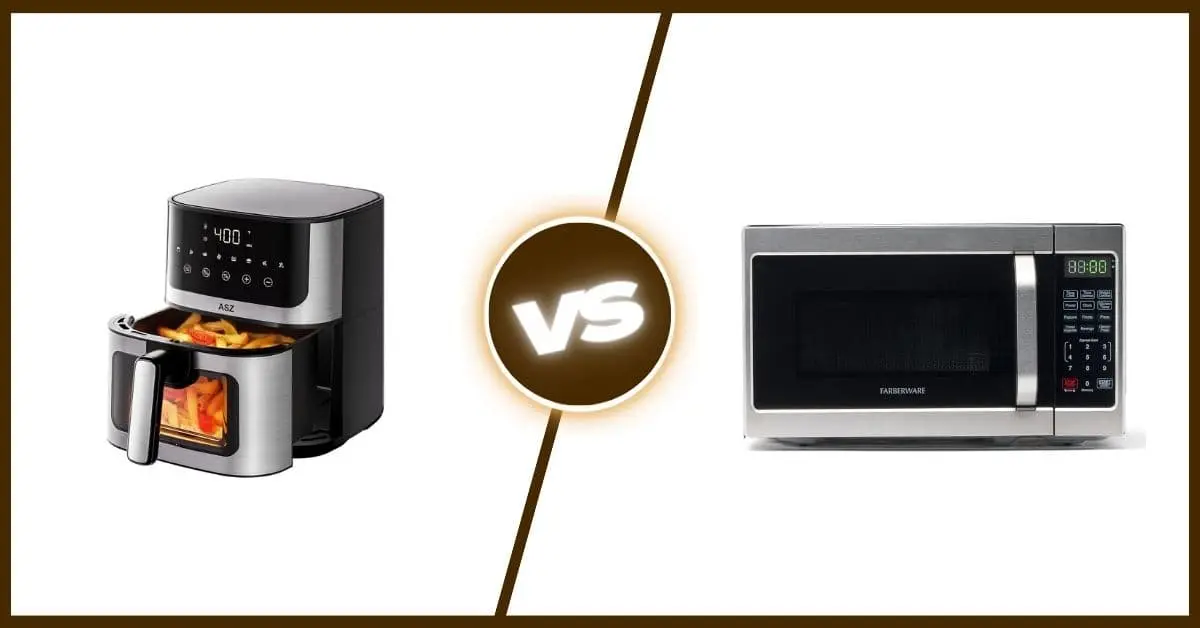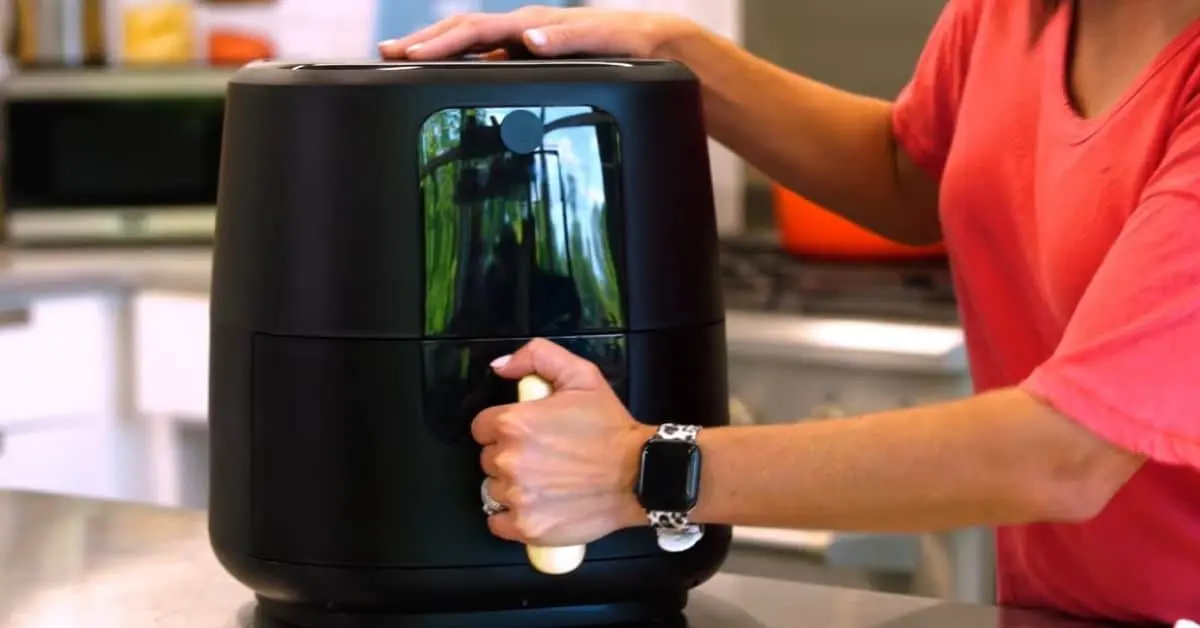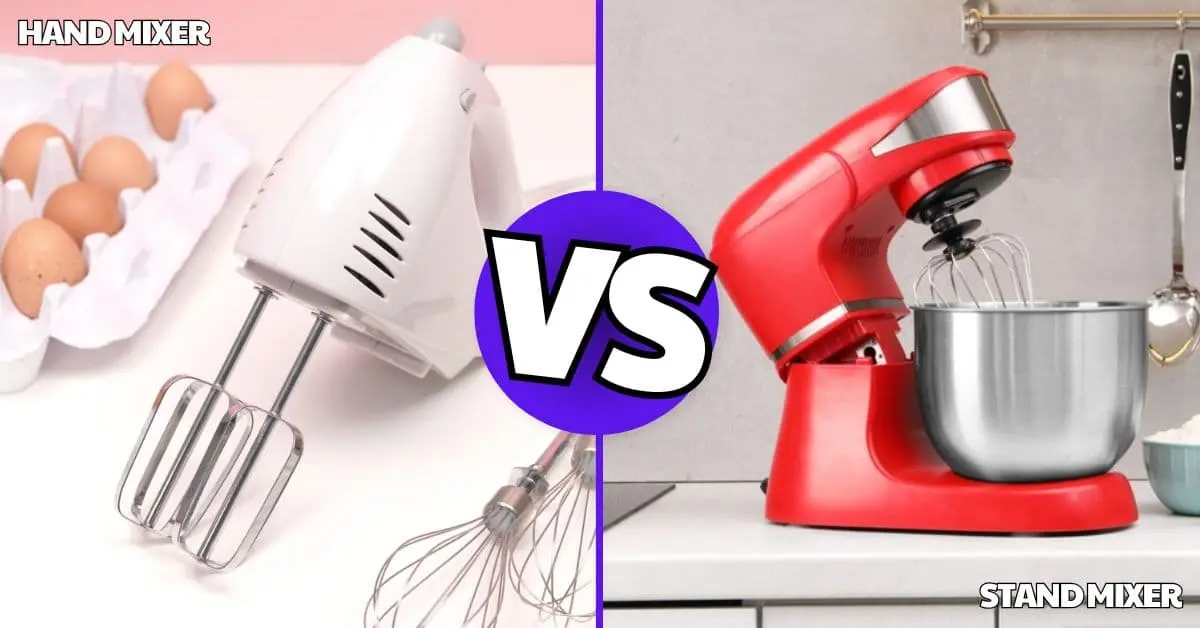When it comes to kitchen appliances, two of the most commonly debated options are the air fryer and the microwave. Both offer convenience, but they serve different purposes. If you’re wondering which one is the better choice for your cooking needs, you’re not alone.
Microwaves have been a kitchen staple for decades, known for their speed and convenience. They’re the go-to appliance for reheating leftovers, defrosting frozen foods, and quick cooking. On the other hand, air fryers have surged in popularity in recent years, promising crispy, golden-brown results with little to no oil—making them a healthier alternative to deep frying.
But can an air fryer truly replace a microwave? Which one is more versatile, energy-efficient, and practical for everyday use? In this detailed comparison, we’ll break down their key differences, advantages, and drawbacks to help you decide which one deserves a spot in your kitchen.
Know the Air Fryers and Microwaves
Before we dive into the detailed comparison, it’s important to understand what each appliance does, how it works, and what makes them unique. While both are designed to make cooking easier, their methods and results are vastly different.
What Is an Air Fryer?
An air fryer is a countertop kitchen appliance that uses hot air circulation to cook food, mimicking the crispiness of deep-fried dishes—but with significantly less oil. Despite its name, an air fryer doesn’t actually “fry” food the way a deep fryer does. Instead, it works more like a small convection oven, circulating hot air around the food at high speed. This creates a crispy outer layer while keeping the inside tender.
Air fryers became incredibly popular due to their ability to deliver crispy, golden-brown textures without excessive oil. They are widely used for cooking foods like fries, chicken wings, vegetables, and even baked goods. Many air fryers come with additional cooking functions, such as roasting, baking, and grilling, making them a versatile option for those looking to prepare healthier meals.
One of the biggest draws of an air fryer is its health benefits. Traditional deep frying requires large amounts of oil, which adds extra calories and unhealthy fats to food. Air frying, on the other hand, requires little to no oil, reducing overall fat content while still providing that satisfying crunch.
However, air fryers do have some limitations. They are generally slower than microwaves when it comes to cooking or reheating food. Additionally, most models have a smaller capacity, meaning you may need to cook in batches if you’re preparing meals for multiple people.
What Is a Microwave?
A microwave is a kitchen essential that has been around for decades, primarily known for its ability to quickly heat and cook food using electromagnetic waves. These waves excite water molecules within food, generating heat that spreads throughout the dish. This makes microwaves incredibly efficient for reheating leftovers, defrosting frozen items, and cooking simple meals in just minutes.
One of the biggest advantages of a microwave is speed. Unlike an air fryer, which requires preheating and longer cooking times, a microwave can warm up food almost instantly. Whether you’re heating up last night’s dinner, making popcorn, or steaming vegetables, a microwave gets the job done in a fraction of the time.
Another key benefit is its ease of use. Microwaves typically have straightforward controls, allowing users to set a cooking time and walk away without needing to monitor the process. They also require minimal cleanup since food is usually placed inside a microwave-safe dish, reducing mess.
Despite its convenience, a microwave has its downsides. Unlike an air fryer, it doesn’t crisp or brown food, which means meals can sometimes turn out soft or soggy instead of crunchy. While a microwave is excellent for reheating and defrosting, it’s not ideal for cooking foods that require a crispy or caramelized texture, like fried chicken or roasted potatoes.
Additionally, while microwaving is generally safe and helps retain nutrients in some foods, certain cooking methods—such as steaming—are better at preserving vitamins compared to the rapid heating process of a microwave.
Air Fryer vs Microwave – Side-by-Side Comparison
To help you quickly compare the differences between an air fryer and a microwave, here’s a detailed side-by-side breakdown of their key features:
| Feature | Air Fryer | Microwave |
| Cooking Method | Uses rapid hot air circulation to crisp and cook food. | Uses electromagnetic waves to heat food from the inside out. |
| Best For | Frying, roasting, baking, grilling, and crisping food. | Reheating, defrosting, steaming, and quickly cooking simple meals. |
| Cooking Speed | Slower than a microwave; requires preheating and longer cooking times. | Extremely fast; reheats food within seconds to a few minutes. |
| Food Texture | Produces a crispy, golden-brown texture similar to deep frying. | Heats food quickly but does not crisp or brown it. |
| Health Benefits | Requires little to no oil, making it a healthier alternative to deep frying. | Preserves nutrients well when steaming or reheating food. |
| Versatility | Can air fry, roast, bake, grill, and even dehydrate food. | Primarily used for reheating, defrosting, and steaming. |
| Ease of Use | Requires some monitoring (shaking or flipping food) for even cooking. | Very easy to use; just set the timer and wait. |
| Cleaning & Maintenance | Needs regular cleaning of the basket and tray due to grease buildup. | Easy to clean with minimal mess since food is contained in dishes. |
| Energy Efficiency | Uses more electricity (1,200-1,800W) and runs for longer periods. | Uses less electricity (600-1,200W) and operates quickly. |
| Size & Capacity | Compact but has a smaller cooking space; may require cooking in batches. | Available in various sizes; larger models can fit full meals. |
| Price Range | Typically ranges from $80 to $300, depending on features. | More affordable, with prices starting from $50 to $150. |
| Ideal For | Those who want crispy, healthier meals with a fried-like texture. | Those who need quick and convenient heating for meals and leftovers. |
Key Differences Between an Air Fryer and a Microwave
Now that we understand how air fryers and microwaves work, let’s compare them across several key factors. Each appliance has its strengths and weaknesses, so the right choice depends on what matters most to you—whether it’s speed, versatility, energy efficiency, or cooking style.

Cooking Method & Technology
The biggest difference between an air fryer and a microwave is how they cook food.
An air fryer uses rapid air circulation powered by a built-in fan and heating element. This process works similarly to a convection oven, where hot air surrounds the food, cooking it evenly and creating a crispy, browned texture. This method is perfect for foods like French fries, chicken tenders, and roasted vegetables that benefit from a crunchy exterior. However, since an air fryer relies on circulating hot air, it takes more time to cook food compared to a microwave.
A microwave, on the other hand, uses electromagnetic waves to heat food. These waves cause water molecules inside the food to vibrate, generating heat from within. This makes microwaves incredibly fast for tasks like reheating leftovers, defrosting frozen food, or quickly cooking simple dishes. However, since microwaves heat food from the inside out, they do not produce a crispy or caramelized texture. Instead, food often comes out soft or moist rather than crunchy.
Cooking Speed & Efficiency
When it comes to speed, the microwave wins without question. Microwaves are designed for rapid heating, making them ideal for busy individuals who need to warm up food in seconds. A microwave can reheat a plate of leftovers in one to two minutes, whereas an air fryer may take five to ten minutes to achieve similar results—especially if crisping is involved.
Cooking raw food also follows this trend. A microwave can steam vegetables, cook oatmeal, or heat up soups almost instantly. In contrast, an air fryer requires preheating and takes more time to cook foods thoroughly. While an air fryer can still be faster than a conventional oven, it doesn’t match the speed of a microwave.
However, if you’re cooking food that benefits from crisping, an air fryer’s longer cooking time is worth it. While microwaves excel at reheating and steaming, they fall short when it comes to delivering texture.
Versatility & Functionality
Both appliances offer versatility but in different ways.
An air fryer is a multifunctional cooking appliance that can fry, bake, roast, and even grill. Many modern air fryer models come with preset cooking modes, allowing you to prepare a variety of dishes with little effort. You can make everything from crispy chicken wings and roasted vegetables to baked goods and even homemade pizza. Some advanced air fryers also function as toaster ovens or dehydrators, expanding their cooking capabilities even further.
A microwave, however, is primarily designed for heating, reheating, and defrosting. While some models come with convection or grilling functions, the standard microwave lacks the ability to crisp or brown food. It is perfect for warming up leftovers, cooking simple meals like instant noodles or scrambled eggs, and defrosting frozen ingredients quickly.
If you’re looking for an appliance that can replace multiple cooking methods, an air fryer offers more functionality. However, if speed and convenience are your priorities, a microwave is still the best choice.
Health & Nutrition
Health-conscious individuals often lean towards air fryers because they allow for oil-free or low-oil cooking. Traditional deep frying requires food to be submerged in hot oil, which adds significant calories and unhealthy fats. In contrast, an air fryer uses minimal or no oil while still delivering a crispy texture. This makes it a great option for anyone looking to enjoy fried-style foods in a healthier way.
Microwaves, however, have their own health benefits. Since microwaves cook food quickly, they help preserve more nutrients compared to other cooking methods that involve prolonged heat exposure. Steaming vegetables in a microwave, for example, retains more vitamins than boiling them on a stovetop.
That said, microwaves are not ideal for cooking certain dishes that require texture, and they don’t necessarily reduce calorie intake like air fryers do. While both appliances have health advantages, the air fryer is better for reducing oil consumption, while the microwave is better for retaining nutrients in steamed or reheated foods.
If you’re wondering whether an air fryer is a healthier alternative to a microwave, it’s important to compare their cooking methods and impact on nutrition. While air fryers use hot air to crisp food with little to no oil, microwaves quickly heat food without altering its fat content. But which one retains more nutrients and offers better health benefits? Check out our in-depth analysis on Is an Air Fryer Healthier Than a Microwave? to find out.
Energy Consumption & Cost Efficiency
Energy efficiency is another key factor to consider. A microwave generally consumes less electricity than an air fryer. Most standard microwaves operate at 600 to 1,200 watts, depending on their size and power rating. They also work quickly, meaning they use electricity for shorter periods. If you only need to reheat or cook something for a few minutes, the microwave is the more energy-efficient option.
An air fryer, on the other hand, requires more energy because it operates at a higher wattage—typically between 1,200 and 1,800 watts—and runs for longer cooking times. If you’re making something like chicken wings, the air fryer might need 20–25 minutes to cook them properly, compared to a microwave that could warm up pre-cooked chicken in under two minutes.
From a cost perspective, microwaves tend to be more affordable upfront, with basic models available for $50 to $150. Air fryers, especially those with advanced features, often range from $80 to $300. While air fryers can potentially save money by reducing the need for oil and replacing multiple appliances, microwaves remain the more budget-friendly choice for those focused on cost and energy efficiency.
Ease of Use & Cleaning
Both appliances are relatively easy to use, but they differ in maintenance and cleaning requirements.
A microwave is extremely user-friendly. Simply place your food inside, press a button, and let it heat up. Cleaning a microwave is also straightforward—most spills or splatters can be wiped down with a damp cloth. Since food is usually contained in a dish, there’s little mess to deal with.
An air fryer requires more effort in both cooking and cleaning. You often need to preheat it, shake or flip food during cooking, and adjust settings to get the best results. Cleaning can also be more involved, as you need to wash the removable basket or tray after each use. Grease and food residue can build up over time, requiring thorough scrubbing.
If convenience is your top priority, the microwave is the winner. However, if you’re willing to put in a bit more effort for healthier and crispier meals, the air fryer is worth it.
Pros and Cons of Air Fryers and Microwaves
Both air fryers and microwaves offer unique benefits, but they also come with drawbacks. Understanding their pros and cons can help you decide which appliance suits your cooking needs best.
Pros and Cons of Air Fryers
Pros:
- Healthier Cooking – Uses little to no oil, reducing fat and calorie intake compared to deep frying.
- Crispy & Golden Texture – Achieves a crunchy, fried-like texture that microwaves cannot replicate.
- Versatile Cooking Options – Can fry, roast, bake, grill, and even dehydrate food.
- Better Taste & Texture – Preserves flavors while giving food a satisfying crunch.
- Compact & Space-Saving – Smaller than ovens but capable of delivering similar results.
Cons:
- Slower Than a Microwave – Takes longer to cook or reheat food, especially compared to the instant heating of a microwave.
- Limited Capacity – Smaller cooking basket means you may need to cook in batches for larger meals.
- Requires Preheating & Monitoring – Some foods require flipping or shaking during cooking for even results.
- More Cleaning Effort – The cooking basket and tray need regular cleaning, and grease buildup can be an issue.
Pros and Cons of Microwaves
Pros:
- Fast & Convenient – Reheats and cooks food in minutes, making it ideal for busy lifestyles.
- Energy-Efficient – Uses less electricity than an air fryer due to shorter cooking times.
- Great for Reheating & Defrosting – Quickly warms up leftovers and defrosts frozen food with ease.
- Low Maintenance – Easy to clean with minimal mess, as food is contained in microwave-safe dishes.
- Budget-Friendly – More affordable than most air fryers, with basic models available at lower prices.
Cons:
- No Crispy Texture – Heats food but does not brown or crisp it, often leading to a soggy or uneven texture.
- Limited Cooking Abilities – Primarily used for reheating, defrosting, and steaming rather than actual cooking.
- Uneven Heating – Some foods heat unevenly, requiring stirring or repositioning for consistent results.
- Food Quality May Suffer – Some dishes can become rubbery or dry when microwaved.
Which One Should You Choose?
Deciding between an air fryer and a microwave depends on your cooking habits, lifestyle, and priorities. Both appliances serve different purposes, so the best choice comes down to what you need most in your kitchen.
Choose an Air Fryer If:
- You love crispy, golden-brown textures similar to deep-fried food.
- You prefer a healthier cooking method with little to no oil.
- You want a versatile appliance that can air fry, roast, bake, grill, and even dehydrate.
- You don’t mind waiting a bit longer for better taste and texture.
- You have space for an additional appliance in your kitchen.
An air fryer is ideal for those who enjoy fried-style meals without the guilt and want more cooking flexibility beyond reheating. It’s perfect for preparing foods like crispy chicken wings, roasted veggies, and even homemade snacks like potato chips. However, it does take longer to cook and requires regular cleaning.
Choose a Microwave If:
- You need speed and convenience for reheating, defrosting, and cooking quick meals.
- You prioritize efficiency and ease of use, with minimal effort required.
- You have a small kitchen or limited counter space and need a compact solution.
- You’re on a budget and want an affordable appliance that saves time and energy.
- You don’t need a crispy texture for most of your meals.
A microwave is perfect for those who want fast meal preparation without worrying about preheating or long cooking times. Whether you’re warming up leftovers, making popcorn, or defrosting frozen food, a microwave is a must-have for sheer convenience. However, it lacks the ability to crisp or brown food, which can impact texture and taste.
Should You Get Both?
For many households, having both appliances is the best solution. Since air fryers and microwaves excel in different areas, they complement each other perfectly. You can use the microwave for quick heating and the air fryer for crispy, flavorful cooking. If you have the budget and counter space, owning both can give you the ultimate flexibility in the kitchen.
Related Read: Air Fryer vs Deep Fryer: Which Is Better
Frequently Asked Questions (FAQs)
Can an air fryer replace a microwave?
Not entirely. While an air fryer can cook and reheat food, it doesn’t match the speed and convenience of a microwave. Microwaves are better for quickly warming up leftovers, defrosting frozen foods, and steaming dishes, while air fryers excel at crisping, roasting, and baking. If you frequently reheat food and want quick results, a microwave is still necessary.
Can I reheat food in an air fryer instead of a microwave?
Yes, but it takes longer. An air fryer can reheat food while restoring its crispiness, making it ideal for pizza, fries, or fried chicken. However, it takes 5-10 minutes, whereas a microwave can do the same job in 1-2 minutes. If you prioritize speed, the microwave is the better option.
Does an air fryer use more electricity than a microwave?
Yes, an air fryer generally consumes more electricity because it operates at a higher wattage (1,200-1,800W) and runs for longer periods. A microwave uses 600-1,200W and heats food much faster, making it a more energy-efficient appliance for quick tasks.
Can I cook raw meat in an air fryer or a microwave?
Yes, both can cook raw meat, but they do so differently. An air fryer can cook and crisp meats like chicken breasts, steak, or fish while keeping them juicy inside. A microwave can also cook raw meat, but it may not brown or crisp it, often leading to a different texture. If you prefer a grilled or fried texture, an air fryer is the better choice.
Which appliance is safer: an air fryer or a microwave?
Both are generally safe when used correctly. However, air fryers get very hot, and touching the basket or interior can cause burns. Microwaves are safer in that regard, but using non-microwave-safe containers can be a hazard. Always follow the manufacturer’s safety guidelines to prevent accidents.
Which one is more budget-friendly: an air fryer or a microwave?
Microwaves are typically cheaper than air fryers, with basic models starting at around $50-$150, while air fryers range from $80-$300 depending on features and capacity. If you need a cost-effective option for reheating and cooking, a microwave is the better choice. However, an air fryer may save money in the long run by reducing the need for oil and replacing multiple appliances.
Final Verdict: Air Fryer vs Microwave – Which One Wins?
Choosing between an air fryer and a microwave depends on what you need most in your kitchen. Both appliances offer unique advantages, and the “best” option depends on your cooking habits, lifestyle, and priorities.
- If you want speed, convenience, and ease of use, the microwave is the clear winner. It quickly reheats leftovers, defrosts frozen food, and cooks simple meals in minutes, making it a must-have for busy households.
- If you prioritize crispy, flavorful, and healthier meals, the air fryer is the better choice. It provides a fried-like texture with little to no oil and offers more versatility for cooking a variety of foods.
However, there’s no absolute winner because they serve different purposes. Many households benefit from having both—using the microwave for fast reheating and the air fryer for cooking crispy, delicious meals. If you have the space and budget, owning both appliances can maximize your kitchen efficiency.
The Bottom Line
- Get a microwave if you need fast, hassle-free heating and defrosting.
- Get an air fryer if you want crispy, healthier meals with better taste and texture.
- Consider both if you want the best of both worlds!
Ultimately, your choice should align with how you cook and what features matter most to you. Whatever you decide, both appliances can make your kitchen experience more convenient and enjoyable!





